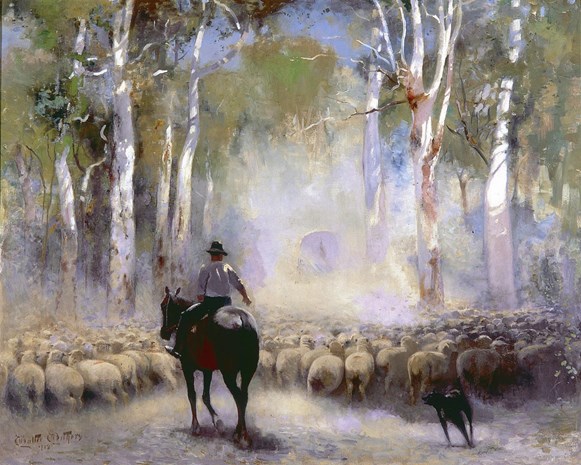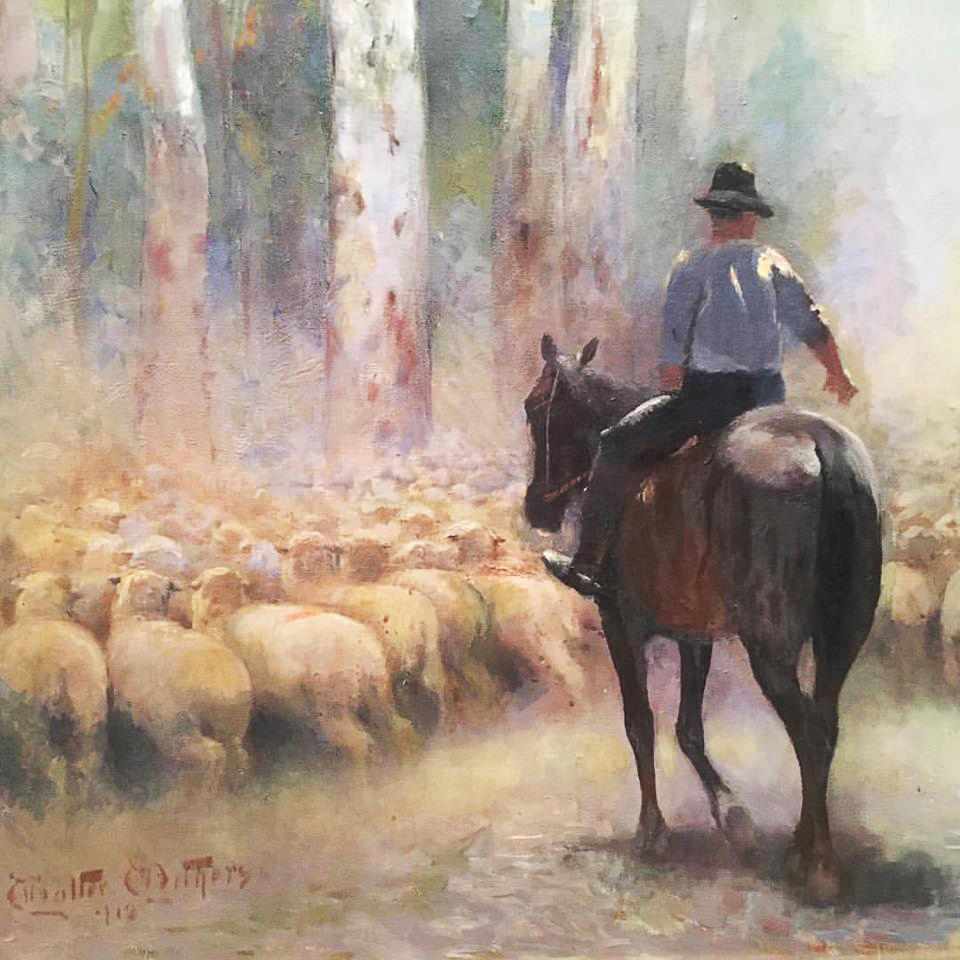Skip to: Object detail; Visual description; About the artist; Context; Conversation; Soundscape; Next artwork
Object detail
Title: The Drover
Artist: Walter Withers
Date: 1912
Object type: Painting
Medium: Oil on canvas
Scale: 102 by 127.4 centimeters
Location: Gallery 14 (the last gallery on the left when walking straight from the entry foyer)
Visual description
The Drover depicts a man on an old horse and his dog, herding a flock of sheep through the Australian bush. They are seen from behind, heading along a dirt path with tall, twisted eucalyptus trees on either side. A covered wagon can be seen faintly in the distance along the path. The air is filled with dust, probably kicked up by the sheep, and the midday sun filters patchily through the trees. The drover wears long trousers, a long sleeve shirt rolled up to the elbows, and an akubra hat. His right arm is raised in a gesture to the dog. The horse is turned slightly to the left, so that you can see its side. The dog is a dark kelpie and is seen twisting to change directions mid-run. The sheep have full, dirty fleeces and are pressed tightly together. You can see indications of their backs and their heads.
The palette of The Drover is mainly pale, with pale golden hues for the sheep in the foreground. Pale blue, cold pale yellow and green are used in the background of sky, trees and dust. Patches of white on the tree trunks and drover’s shirt indicate the bright light of the midday sun. Some of the brushstrokes are visible.
The painting is displayed in a deep, wide wooden frame with ornate carvings, painted gold.
About the artist
Walter Withers was born in 1854 in Warwickshire, England. He died in 1914 in Eltham, Victoria, Australia.
Walter Withers was involved with the ‘Heidelberg School’ in the period of the first artists camps at Eaglemont. Withers set up ‘Charterisville’ and stayed in the Heidelberg/Eltham area long after the other members of the ‘School’ had gone. It is clear that Withers occupied a somewhat unique position. In 1889-90 at a time when Frederick McCubbin and the others were still painting in a conventional style, Withers was experimenting with a brave and confident impressionistic style. He was probably the first artist to paint major works using techniques of impasto. In reviewing the output of the Heidelberg artists it becomes apparent that there are more impressionistic paintings executed by Withers than by any other Australian artist.
Context
The Heidelberg School
Walter Withers was a member of the Heidelberg School, a group of artists working in groups en plein air (outdoors) in Sydney and Melbourne. The most noted members of the group were Tom Roberts, Frederick McCubbin and Charles Conder.
Combining Australian nationalism with impressionist painting techniques, the Heidelberg School artists sought to explore Australian life, the bush, Australia’s unique light, and to tell classic stories of Australian folklore. Their works are considered to be the first to realistically and sensitively depict the Australian landscape.
Subject matter
In keeping with the Heidelberg tradition, The Drover tells a story of a uniquely Australian way of life. Withers’ wife described the painting as realistic, capturing a lifestyle that was fast disappearing. The Drover was painted in Eltham (near Heidelberg), in Victoria. The local butcher, Mr Capewell, posed with his own horse and dog.
Bendigo Art Gallery
The Drover was purchased in 1916 through the Mr. David Whyte Bequest Fund.
Conversation
Questions and answers about The Drover, recorded in the gallery space.
Soundscape
Sheep, drover and dog.
Next artwork
Paintings: The Golden Wedding; A Primrose from England.
Sculptures: Folly; Venus Tying her Sandal.


